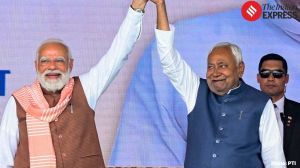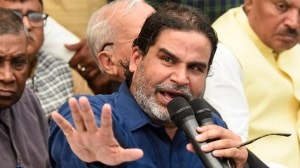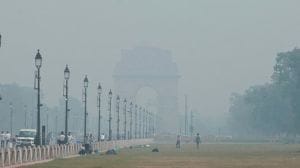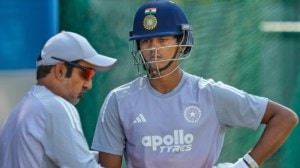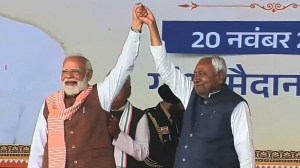Priya Kumari Shukla is a Senior Copy Editor in the Indian Express (digital). She contributes to the UPSC Section of Indian Express (digital) and started niche initiatives such as UPSC Key, UPSC Ethics Simplified, and The 360° UPSC Debate. The UPSC Key aims to assist students and aspirants in their preparation for the Civil Services and other competitive examinations. It provides valuable guidance on effective strategies for reading and comprehending newspaper content. The 360° UPSC Debate tackles a topic from all perspectives after sorting through various publications. The chosen framework for the discussion is structured in a manner that encompasses both the arguments in favour and against the topic, ensuring comprehensive coverage of many perspectives. Prior to her involvement with the Indian Express, she had affiliations with a non-governmental organisation (NGO) as well as several coaching and edutech enterprises. In her prior professional experience, she was responsible for creating and refining material in various domains, including article composition and voiceover video production. She has written in-house books on many subjects, including modern India, ancient Indian history, internal security, international relations, and the Indian economy. She has more than eight years of expertise in the field of content writing. Priya holds a Master's degree in Electronic Science from the University of Pune as well as an Executive Programme in Public Policy and Management (EPPPM) from the esteemed Indian Institute of Management Calcutta, widely recognised as one of the most prestigious business schools in India. She is also an alumni of Jamia Milia Islamia University Residential Coaching Academy (RCA). Priya has made diligent efforts to engage in research endeavours, acquiring the necessary skills to effectively examine and synthesise facts and empirical evidence prior to presenting their perspective. Priya demonstrates a strong passion for reading, particularly in the genres of classical Hindi, English, Maithili, and Marathi novels and novellas. Additionally, she possessed the distinction of being a cricket player at the national level. Qualification, Degrees / other achievements: Master's degree in Electronic Science from University of Pune and Executive Programme in Public Policy and Management (EPPPM) from Indian Institute of Management Calcutta ... Read More
UPSC Key: Deportation, Quadrilateral Security Dialogue and Sustainable Development Goals
Why ‘America First’ trade policy is relevant to the UPSC exam? What is the significance of topics such as Hypersonic Technology Demonstrator Vehicle, India’s dependence on crude oil and Indus Waters Treaty on both the preliminary and main exams? You can learn more by reading the Indian Express UPSC Key for January 23, 2025.
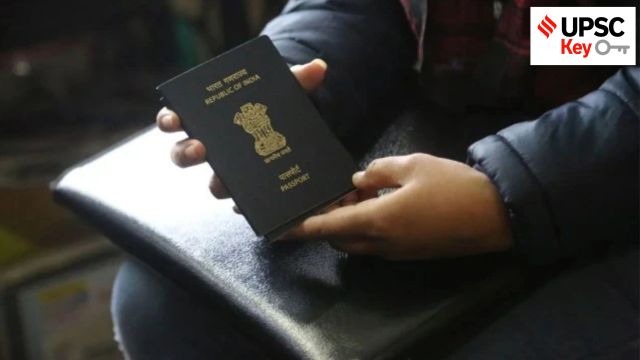 UPSC Key January, 2025: Here's what you should be reading from the January 23, 2025 edition of The Indian Express
UPSC Key January, 2025: Here's what you should be reading from the January 23, 2025 edition of The Indian Express Important topics and their relevance in UPSC CSE exam for January 23, 2025. If you missed the January 22, 2025 UPSC CSE exam key from the Indian Express, read it here
FRONT PAGE
US brings up irregular immigration, India says always open to return
Syllabus:
Preliminary Examination: Current events of national and international importance.
Main Examination: General Studies II: Effect of policies and politics of developed and developing countries on India’s interests, Indian diaspora.
What’s the ongoing story: Newly appointed US Secretary of State Marco Rubio raised the issue of “irregular immigration” in his very first meeting with External Affairs Minister S Jaishankar in Washington DC Wednesday.
Key Points to Ponder:
• What does deportation mean?
• Why Donald Trump wants to deport Indians?
• What will the implications of the U.S. administration’s intensified deportation policies on the Indians?
• How does this decision of U.S. administration can affect India-U.S. bilateral relations?
• Does Government of India have any strategy to repatriate approximately 18,000 undocumented Indian immigrants from the United State?
• What is the significance of the H-1B visa program for India’s skilled workforce?
• Examine the role of diplomatic negotiations in addressing issues related to undocumented immigrants.
• How can India and the United States collaborate to find mutually beneficial solutions?
• Assess the socio-economic-emotional impact on families of undocumented Indian immigrants facing deportation from the United States.
Key Takeaways:
• The two sides are also discussing the possibility of a meeting between Prime Minister Narendra Modi and US President Donald Trump on the sidelines of the AI summit in Paris on February 11-12, sources said.
• Jaishankar told reporters that “levels of trust are very high” and “the trust is a more systemic sentiment”.
• “There’s a very visible chemistry between Prime Minister Modi and President Trump, and that also, in a sense, percolates through the system and reinforces that comfort and trust… So, there was a very visible appetite to get this relationship moving to do more, to set bigger goals. So that was a sort of feeling in the room,” he said.
• Rubio “emphasised the Trump administration’s desire to work with India to advance economic ties and address concerns related to irregular migration”, State Department spokesperson Tammy Bruce said in a readout after the meeting.
• Jaishankar framed the conversation about mobility of people. “We have a position on mobility, which is a principled position, applies to all countries as a government. We obviously are very much supportive of legal mobility, because we do believe in a global workplace.
• On economic cooperation, he said “the overall sense is there are a lot of opportunities here… in an era of more technology-centric progress, the message I got was we appreciate the value of India as a partner. There are domains we want to work on.
• The twin themes of illegal immigration and tariffs are expected to dominate the conversation between Delhi and Washington DC in the Trump 2.0 administration.
Do You Know:
• If the Trump administration moves on deportations, among the first affected could be the 20,407 “undocumented” Indians, as of November 2024, who are either facing “final removal orders” or are, currently, in detention centres of the US Immigration and Customs Enforcement (ICE). Of these, 17,940 “paperless” Indians are not in detention but are under “final removal orders,” and another 2,467 are in detention under ICE’s Enforcement and Removal Operations (ERO).
• This makes Indians the fourth largest group by nationality, and the first among Asians, in ICE custody. As of November 2024, the total number of non-citizens, from all countries, detained added up to over 37,000.
• Incidentally, ICE has named India with Iraq, South Sudan, and Bosnia-Herzegovina in the list of 15 “uncooperative” countries reluctant to accept their “undocumented’ citizens back from the US.
• Classification as “uncooperative,” covers: “hindering” ICE’s “removal” efforts by refusing to conduct consular interviews; refusing to accept charter removal missions; delaying removal proceedings.
• According to ICE’s 2024 Annual Report, the number of Indians deported has already jumped five-fold in four years: from 292 in 2021 to 1,529 in 2024.
• However, deportation data is often computed loosely. Sharing information on a charter flight that brought back an unspecified number of ‘undocumented’ adult Indians to Punjab last October, an assistant secretary with the Department of Homeland Security put the number of Indians repatriated through charter and commercial flights between October 2023 and September 2024 at 1,100.
• On December 6, Minister of State for External Affairs Kirti Vardhan Singh told Lok Sabha that “as per US Government data, a total of 519 Indian nationals were deported to India” between November 2023 and October 2024.
• The apparent discrepancies possibly stem from the inclusion of voluntary returns, departures and withdrawals — cases where a non-citizen is allowed to leave the US or withdraw an application for admission without any immigration consequences — in ICE’s removal records, along with repatriations executed under final removal orders.
• Non-citizens can appeal to the Board of Immigration Appeals (BIA) in the US against an order of removal issued by an immigration judge. If the BIA affirms the immigration judge’s order of removal, it becomes administratively final.
Other Important Articles Covering the same topic:
📍Express View on Trump’s anti-immigration agenda: There will be costs for both India and the US
UPSC Practice Prelims Question Covering similar theme:
1. Which visa program is particularly significant for skilled Indian workers seeking employment in the United States?
a) L-1 Visa
b) H-1B Visa
c) J-1 Visa
d) F-1 Visa
UPSC Previous Year Mains Question Covering similar theme:
📍‘What introduces friction into the ties between India and the United States is that Washington is still unable to find for India a position in its global strategy, which would satisfy India’s National self-esteem and ambitions’. Explain with suitable examples. (UPSC CSE, GS2, 2019)
GOVT & POLITICS
Quad message to China: Oppose any action to alter status quo
Syllabus:
Preliminary Examination: Current events of national and international importance.
Main Examination: General Studies II: Bilateral, regional and global groupings and agreements involving India and/or affecting India’s interests.
What’s the ongoing story: US Secretary of State Marco Rubio held his first multilateral meeting on Tuesday as the foreign ministers of the Quad grouping – India, the US, Australia, and Japan – gathered in Washington DC and vowed to “strongly oppose any unilateral actions that seek to change the status quo by force or coercion”, a statement aimed at China’s assertive behaviour in the Indo-Pacific region.
Key Points to Ponder:
• What is QUAD?
• Discuss the strategic significance of the Quadrilateral Security Dialogue (Quad) in the context of the Indo-Pacific region.
• How does the Quad aim to address the challenges posed by unilateral actions that seek to alter the status quo by force or coercion?
• What are the implications of the Quad foreign ministers’ joint statement opposing unilateral actions that change the status quo by force or coercion?
• Do you think that recent Quad foreign ministers’ joint statement can influence regional stability and international relations, particularly concerning China’s activities in the Indo-Pacific?
• Assess India’s role and interests within the Quad framework.
• How does India’s participation in QUAD align with its broader foreign policy objectives, especially in maintaining a free and open Indo-
Pacific?
Key Takeaways:
• On his first day on the job, Rubio held talks with External Affairs Minister S Jaishankar and his Australian and Japanese counterparts Penny Wong and Takeshi Iwaya.
• In a joint statement, the four nations said officials would meet regularly to prepare for an upcoming leaders’ summit in India, likely this year.
• “We, the Secretary of State of the United States and the Foreign Ministers of Australia, India, and Japan, met today in Washington D.C. to reaffirm our shared commitment to strengthening a Free and Open Indo-Pacific where the rule of law, democratic values, sovereignty, and territorial integrity are upheld and defended,” a readout by the US State Department said.
• “Our four nations maintain our conviction that international law, economic opportunity, peace, stability, and security in all domains including the maritime domain underpin the development and prosperity of the peoples of the Indo-Pacific. We also strongly oppose any unilateral actions that seek to change the status quo by force or coercion,” it added.
• “We are committed to strengthening regional maritime, economic, and technology security in the face of increasing threats, as well as promoting reliable and resilient supply chains. We look forward to advancing the work of the Quad in the coming months and will meet together on a regular basis as we prepare for the next Quad Leaders’ Summit hosted by India,” it further said.
• “Significant that the Quad (foreign ministers’ meeting) took place within hours of the inauguration of the Trump Administration. This underlines the priority it has in the foreign policy of its member states,” Jaishankar said on X after the meeting.
Do You Know:
• Following the Indian Ocean tsunami of December 2004, India, Japan, Australia, and the US created an informal alliance to collaborate on disaster relief efforts. In 2007, then PM of Japan, Shinzo Abe, formalised the alliance, as the Quadrilateral Security Dialogue or the Quad.
• But this nascent group was hampered by a lack of cohesion amongst members and accusations that the Quad was nothing more than an anti-China bloc. Thus, the early iteration of the Quad, largely based on maritime security, eventually dissipated. In 2017, faced again with the rising Chinese challenge, the four countries revived the Quad, and broadened its objectives.
• Nonetheless, the Quad is not structured like a typical multilateral organisation, and lacks a secretariat and any permanent decision-making body (like the EU or UN). Instead, it has focused on expanding existing agreements between member countries and highlighting their shared values. Additionally, unlike NATO, the Quad does not include provisions for collective defence, instead choosing to conduct joint military exercises as a show of unity and diplomatic cohesion.
• In 2020, the trilateral India-US-Japan Malabar naval exercises expanded to include Australia, marking the first official grouping of the Quad since its resurgence in 2017, and the first joint military exercises among the four countries in over a decade. In March 2021, the Quad leaders met virtually and later released a joint statement titled ‘The Spirit of the Quad,’ which outlined the group’s approach and objectives. The first in-person meeting was held in Washington DC, later that year.
• The group’s primary objectives include maritime security, addressing the risks of climate change, creating an ecosystem for investment in the region, and boosting technological innovation. In 2020-21, the grouping also collaborated to combat the Covid-19 crisis, especially vis-à-vis vaccine diplomacy.
• Quad members have also indicated a willingness to expand the partnership through a so-called Quad Plus that would include South Korea, New Zealand, and Vietnam, amongst others.
Other Important Articles Covering the same topic:
📍PM Modi in US: What is the Quad grouping?
UPSC Practice Prelims Question Covering similar theme:
2. Which countries constitute the Quadrilateral Security Dialogue (Quad)?
a) India, Australia, Japan, and the United States
b) India, Australia, South Korea, and the United States
c) India, New Zealand, Japan, and the United States
d) India, Australia, Japan, and Canada
UPSC Previous Year Mains Question Covering similar theme:
📍Quadrilateral Security Dialogue (Quad) is transforming itself into a trade bloc from a military alliance, in present times Discuss. (UPSC CSE, GS2, 2020)
📍What do you understand by ‘The String of Pearls’? How does it impact India? Briefly outline the steps taken by India to counter this. (UPSC CSE, GS2, 2013)
India on track to meet SDG health targets well ahead of 2030: Govt
Syllabus:
Preliminary Examination: Current events of national and international importance.
Main Examination: General Studies II: Issues relating to development and management of Social Sector/Services relating to Health, Education, Human Resources.
What’s the ongoing story: The Union Cabinet on Wednesday reviewed the progress under the National Health Mission (NHM) over the last three years and was informed that with significant progress towards achieving the Sustainable Development Goals (SDGs), India is on track to meet its health targets well ahead of the 2030 deadline.
Key Points to Ponder:
• Examine the role of Sustainable Development Goal 3 in addressing global health challenges.
• Analyse India’s progress toward achieving SDG 3.
• What are the key factors contributing to India’s progress in achieving Sustainable Development Goal 3 (Good Health and Well-being) ahead of the 2030 deadline?
• What role has the National Health Mission (NHM) played in this advancement?
• Discuss the importance of universal health coverage (UHC) as a key target under SDG 3.
Key Takeaways:
• The Cabinet, chaired by Prime Minister Narendra Modi, was apprised of the progress under NHM during 2021-22, 2022-23 and 2023-24 on Wednesday.
• The Cabinet gave its nod to continue the mission for the next two years. The Cabinet was also apprised of accelerated decline in maternal mortality rate, infant mortality rate, under 5 mortality rate and total fertility rate and the progress in respect of various diseases programmes like TB, malaria, kala-azar, dengue, tuberculosis, leprosy, viral hepatitis etc. and new initiatives undertaken such as National Sickle Cell Anaemia Elimination Mission.
• The measles-rubella vaccination campaign covered 97.9% of the desired target. The Maternal Mortality Ratio has declined from 130 in 2014-15 to 97 in 2018-20, a reduction of 25%. “There has been a reduction of 83% since 1990, which is much higher than the average global decline of 45%,” said Union Minister Piyush Goyal while briefing the media.
• The under-5 mortality — number of children who die before reaching the age of 5 per 1,000 live births — has also decreased from 45 in 2014 to 32 in 2020. Similarly, the Infant Mortality Rate has fallen from 39 per 1,000 live births in 2014 to 28 in 2020. One of the key achievements of the programme was also adding 5.23 lakh healthcare workers.
Do You Know:
• The United Nations defines sustainable development as “development that meets the needs of the present without compromising the ability
of future generations to meet their own needs”.
• The 193 Member States of the United Nations, following negotiations that lasted from July 2012 had agreed upon the text of a new document entitled, “Transforming Our World: The 2030 Agenda for Sustainable Development”.
—This agenda contains 17 goals and 169 targets. The goals are to be achieved by all member countries within the next fifteen years, thereby giving it the moniker of ‘Agenda for 2030’.
• End poverty in all forms; end hunger, achieve food security and improved nutrition and promote sustainable agriculture; ensure inclusive and equitable quality education; achieve gender equality and empower all women and girls; ensure availability and sustainable management of water and sanitation for all; ensure access to affordable, reliable, sustainable and modern energy for all; promote sustained, inclusive and sustainable economic growth, full and productive employment; build resilient infrastructure, promote inclusive and sustainable industrialization and foster innovation; reduce inequality within and among countries; make cities and human settlements inclusive, safe, resilient and sustainable; ensure sustainable consumption and production patterns; take urgent action to combat climate change and its impacts; conserve and sustainably use the oceans, seas and marine resources; protect, restore and promote sustainable use of terrestrial ecosystems, sustainably manage forests, combat desertification, and halt and reverse land degradation and halt biodiversity loss; promote peaceful and inclusive societies for sustainable development, provide access to justice for all and build effective, accountable and inclusive institutions at all levels; strengthen the means of implementation and revitalize the global partnership for sustainable development.
Other Important Articles Covering the same topic:
📍UN Sustainable Development Goals: Here’s what you need to know
UPSC Previous Year Prelims Question Covering similar theme:
3. Consider the following statements: (UPSC CSE, 2016)
1. The Sustainable Development Goals were first proposed in 1972 by a global think tank called the ‘Club of Rome’.
2. The Sustainable Development Goals have to be achieved by 2030.
Which of the statements given above is/are correct?
(a) 1 only
(b) 2 only
(c) Both 1 and 2
(d) Neither 1 nor 2
UPSC Previous Year Mains Question Covering similar theme:
📍National Education Policy 2020 is in conformity with the Sustainable Development Goal-4 (2030). It intends to restructure and reorient education system in India. Critically examine the statement. (2020)
DRDO conducts key scramjet test in major step towards developing hypersonic missile
Syllabus:
Preliminary Examination: Current events of national and international importance.
Main Examination: General Studies III: Achievements of Indians in science & technology; indigenization of technology and developing new technology.
What’s the ongoing story: AMID A global race to develop hypersonic munitions, the Defence Research and Development Organisation (DRDO) recently demonstrated a cutting-edge “active cooled scramjet combustor ground test” for 120 seconds for the first time in India. The successful ground test marks a crucial milestone in developing next-generation hypersonic missiles, the Ministry of Defence (MoD) said.
Key Points to Ponder:
• Know the terms and Difference between-Infra Sonic, Subsonic, Super Sonic, Ultra Sonic, Hypersonic etc.
• Hypersonic Missiles-what are they?
• What is Hypersonic Technology Demonstrator Vehicle (HSTDV)
• What speed is a Mach?
• What is Ramjet?
• What is the difference between a ramjet and scramjet?
• Discuss the strategic advantages and challenges of hypersonic missile technology. How can this technology enhance India’s defence capabilities?
• Analyse India’s progress in developing hypersonic missile technology, including key achievements like the HSTDV (Hypersonic Technology Demonstrator Vehicle). What are the implications of this for national security?
Key Takeaways:
• The Defence Research and Development Laboratory (DRDL), a Hyderabad-based facility of DRDO, has been working on development of a long-duration supersonic combustion ramjet or scramjet-powered hypersonic technology.
• The MoD said the ground test of the scramjet combustor showcased several notable achievements, demonstrating its potential for operational use in hypersonic vehicles, like successful ignition and stable combustion. Officials said the ignition in a scramjet engine is like ‘keeping a candle lit in a hurricane’.
• Another key achievement is the development of Thermal Barrier Coating (TBC), which is designed to withstand extreme temperatures encountered during hypersonic flight.
• A new advanced ceramic TBC having high thermal resistance and capable of operating beyond melting point of steel has been jointly developed by DRDL and Department of Science and Technology (DST) facilities.
• The coating is applied inside the scramjet engine using special deposition methods that enhance their performance and longevity.
Do You Know:
• Hypersonic missiles are a class of advanced weaponry that travel at speeds greater than ‘Mach 5’, or more than five times the speed of sound. These advanced weapons have the potential to beat existing Air Defence Systems of major military powers across the world and deliver rapid and high-impact strikes.
• Hypersonic weapons, which fly at speeds in excess of Mach 5, or five times the speed of sound, could pose crucial challenges to missile defense systems because of their speed and manoeuvrability.
• Several nations including the US, Russia, India and China are actively pursuing hypersonic technology and have demonstrated various levels of development.
• The key to hypersonic vehicles is scramjets, which are variants of a category of jet engines called the air breathing engines. The ability of the engines to handle airflows at speeds in multiples of speed of sound without using any moving parts gives them the capability of operating at those speeds.
• Scramjet combustor incorporates an innovative flame stabilisation technique that holds continuous flame inside the combustor with air speeds more than 1.5 km per second.
• Many novel and promising ignition and flame-holding techniques were studied by the DRDO scientists over multiple ground tests before arriving at the scramjet engine configuration.
• Advanced Computational Fluid Dynamics (CFD) simulation tools were used for their evaluation and performance prediction.
• Earlier in September 2020, in another major milestone in India’s hypersonic technology development, the DRDO had successfully flight-tested the Hypersonic Technology Demonstrator Vehicle (HSTDV).
• In this test, the hypersonic cruise vehicle was launched using a solid rocket motor, which took it to an altitude of 30 km, where the aerodynamic heat shields were separated at hypersonic Mach number.
• The hypersonic combustion sustained and the cruise vehicle continued on its desired flight path at hypersonic speed for more than 20 seconds.
Other Important Articles Covering the same topic:
📍Scramjet vehicle: The significance and capability of the HSTDV
UPSC Previous Year Prelims Question Covering similar theme:
4. What is “Terminal High Altitude Area Defense (THAAD)”, sometimes seen in the news? (2018)
(a) An Israeli radar system
(b) India’s indigenous anti-missile programme
(c) An American anti-missile system
(d) A defence collaboration between Japan and South Korea.
5. With reference to Agni-IV Missile, which of the following statements is/are correct? (2014)
1. It is a surface-to-surface missile.
2. It is fuelled by liquid propellant only.
3. It can deliver one-tonne nuclear warheads about 7500 km away.
Select the correct answer using the code given below:
(a) 1 only
(b) 2 and 3 only
(c) 1 and 3 only
(d) 1, 2 and 3
ECONOMY
Inter-ministerial huddle on possible trade policy changes by Washington
Syllabus:
Preliminary Examination: Current events of national and international importance
Main Examination: General Studies II: Effect of policies and politics of developed and developing countries on India’s interests, Indian diaspora.
What’s the ongoing story: The Commerce and Industry Ministry has begun inter-ministerial talks to better prepare for likely changes in US trade policy that could involve tariffs on Indian goods exports to the US under the new Donald Trump administration, a government official said on Wednesday.
Key Points to Ponder:
• Discuss the potential implications of the “America First” trade policy under President Trump’s second term on India’s trade dynamics.
• How should India strategize to safeguard its economic interests?
• Analyse the role of the U.S. Trade Representative in formulating and implementing trade policies.
• Evaluate the concept of “decoupling” in the context of U.S.-China trade relations.
• Examine the significance of the Trade Promotion Authority (TPA) in the U.S. legislative framework.
Key Takeaways:
• This comes a day after Trump instructed his commerce and treasury departments to investigate the causes of America’s “large and persistent” annual trade deficits in goods and announced a new ‘External Revenue Service (ERS)’ to collect tariffs from foreign governments.
• Notably, the TPF is a platform for the US and India to discuss and resolve trade and investment issues.
• The TPF is a key part of the bilateral trade relationship between the two countries. Concerns over the next TPF meet arise as Trump has also directed the United States Trade Representative (USTR) to review existing US trade agreements and sectoral trade agreements and to “recommend any revisions that may be necessary” or appropriate to achieve or maintain the general level of reciprocal and mutually advantageous concessions with respect to free trade agreement partner countries.
• Moreover, India, the US, and 12 other members, including Australia, Indonesia, and Japan, signed an Indo-Pacific Economic Framework (IPEF), a regional agreement to increase economic integration and cooperation in the Indo-Pacific.
• India is a signatory to three pillars of the IPEF: supply chains, clean economy, and fair economy.
• India’s final consumer goods segment may emerge as a significant trade target, as the country recorded its largest trade surplus with the United States in 2023, policy research institute Research and Information System for Developing Countries (RIS) said in a report.
Do You Know:
• Despite attempts to diversify exports, India’s dependence on the US has grown over the past decade. According to official 2022–23 data, the US accounts for 18 per cent of India’s exports, compared to 10 per cent in 2010–11.
• India’s export basket to the US is well-diversified, benefiting industries ranging from textiles to electronics and engineering. However, Trump’s promised tariffs may primarily target China, given the far larger trade imbalance. A fresh round of US–China trade wars could benefit India by attracting investments and manufacturing away from China.
• During his first term, Trump invoked national security provisions to impose a 25 per cent tariff on steel and 10 per cent on aluminium from India and other countries, breaking from the practice of not targeting friendly nations.
• Biden chose to negotiate with India and the European Union rather than lifting these tariffs. Trump has repeatedly voiced his frustration at high tariffs in India, which affect US companies like Harley-Davidson. At a rally last month, he criticised China, Brazil, and India, and called India a “tariff king” and “trade abuser”.
Other Important Articles Covering the same topic:
📍What Trumponomics means for India, the world
UPSC Practice Prelims Question Covering similar theme:
6. The “Trade Promotion Authority” (TPA) in the U.S. context allows:
a) The President to unilaterally impose tariffs
b) Congress to negotiate trade agreements directly
c) The executive branch to negotiate trade deals based on congressional guidelines
d) States to set their own trade policies
India’s oil demand likely to hit yet another record in 2025-26
Syllabus:
Preliminary Examination: Current events of national and international importance.
Main Examination: General Studies III: Infrastructure: Energy, Ports, Roads, Airports, Railways etc.
What’s the ongoing story: India’s consumption of refined petroleum fuels and products is projected to hit yet another fresh high in the financial year 2025-26 (FY26) on the back of steady growth in energy use in various sectors of the economy.
Key Points to Ponder:
• What percentage of India’s oil is imported?
• How can India reduce its dependency on oil imports?
• What crude oil means?
• What are the types of crude oil?
• Why India is dependent on crude oil?
• Where does India import oil?
• India’s domestic crude oil and natural gas production has declined steadily-why?
• What steps have been taken by the Government of India to reduce the imports of crude oil?
• What is the difference between Open Acreage Licensing Programme (OALP), New Exploration Licensing Policy (NELP) and Hydrocarbon Exploration and Licensing Policy (HELP)?
• How high reliance on imported crude oil impacts the Indian economy?
Key Takeaways:
• According to the latest projections by the Petroleum Planning & Analysis Cell (PPAC) of the oil ministry, consumption of petroleum products—seen as a proxy for crude oil demand—is seen rising 4.7 per cent over the revised estimate for FY25 to 252.93 million tonnes.
• The consumption growth is expected to be led by fuels and products like petrol, aviation turbine fuel (ATF), liquefied petroleum gas (LPG), diesel, and petroleum coke.
• Late December, S&P Global Commodity Insights (SPGCI) had said that India was expected to end 2024 with an oil demand growth rate surpassing that of China, making the South Asian country one of the fastest-growing major oil consumption centres globally.
• China is the world’s second-largest consumer of crude oil behind the United States (US), but is the commodity’s biggest importer globally. But oil demand growth in China has been subdued in the post-pandemic era due to a combination of factors.
• In February 2024, Paris-based International Energy Agency (IEA) had said that India’s oil demand growth was expected to overtake China’s by 2027, making the former the biggest driver of global oil demand growth through the remainder of the decade “underpinned by strong economic and demographic growth”, notwithstanding the growing electric vehicle (EV) penetration, energy efficiency, and rising biofuel consumption.
Do You Know:
• India’s petroleum consumption has been scaling new heights with each passing year, with the exception of two years when demand was hit because of the COVID-19 pandemic.
• The revised estimate for the current fiscal—241.68 million tonnes—is slated to be the highest-ever petroleum product consumption level so far, but will likely be topped in the next fiscal.
• The current record consumption level—234.26 million tonnes—was achieved in FY24.
• An analysis of historical data shows that the pre-pandemic record for consumption of petroleum products was 214.13 million tonnes in FY20.
• Demand took a hit in FY21 due to the pandemic, and posted a modest recovery in FY22. Consumption of most products breached pre-pandemic highs in FY23, and have been rising since.
• Unlike many countries, India is seen as a major growth centre for oil demand given the future potential in energy-intensive industries, growing vehicle sales, a rapidly expanding aviation sector, expected growth in consumption of petrochemicals, and a still growing population with relatively low per-capita energy consumption.
• In fact, India is among the few markets where refinery capacity is expected to expand substantially over the coming years. India currently has a refining capacity of nearly 257 million tonnes per annum.
• India is the world’s third-largest consumer of crude oil with an oil import dependency of over 85 per cent.
• Consumption of all major fuels—diesel, petrol, and liquefied petroleum gas (LPG)—is likely to touch an all-time high in the next fiscal, per PPAC projections.
• Consumption of diesel, which is the most used petroleum fuel in the country, is seen rising 2.8 per cent over the current fiscal’s revised estimate to 94.12 million tonnes in FY26.
• Petrol consumption is seen higher by 6.6 per cent at 42.64 million tonnes. Higher demand for these two fuels usually reflects robustness in the transportation and industrial segments.
• LPG consumption is seen rising 4.7 per cent year-on-year to 33 million tonnes. Consumption of ATF, or jet fuel, is projected to register a nearly 10 per cent rate of growth to 9.95 million tonnes in FY26, against the revised estimate of 9.06 million tonnes for FY25.
• High ATF demand growth is representative of the strong growth in India’s civil aviation market, which is now the third-largest domestic aviation market, and one that is expanding rapidly.
• The consumption of petroleum coke, or petcoke, is also seen rising 10 per cent year-on-year to 24.85 million tonnes in FY26, per PPAC projections.
• Petcoke is used as a fuel in various industries, including power, cement, steel, fertiliser, and glass, apart from being a feedstock in the manufacturing of products like aluminium, paints, and coatings.
Other Important Articles Covering the same topic:
📍Explained: The fall in crude oil prices, and its impact in India
UPSC Previous Year Prelims Question Covering similar theme:
7. The term ‘West Texas Intermediate’, sometimes found in news, refers to a grade of (2020)
(a) Crude oil
(b) Bullion
(c) Rare earth elements
(d) Uranium
EXPLAINED
Why Neutral Expert’s decision on IWT is a win for India
Syllabus:
Preliminary Examination: Current events of national and international importance.
Main Examination: General Studies II: India and its neighborhood- relations.
What’s the ongoing story: The Neutral Expert appointed by the World Bank under the terms of the Indus Waters Treaty (IWT) has decided that he is “competent” to adjudicate on the differences between India and Pakistan regarding the design of two hydroelectric projects in Jammu and Kashmir, vindicating New Delhi’s long-held position.
Key Points to Ponder:
• What is the Indus Waters Treaty?
• What is the ongoing dispute about?
• Why is the Expert’s decision significant?
• What is the future of the IWT?
Key Takeaways:
• “The decision upholds and vindicates India’s stand that all the seven questions that were referred to the Neutral Expert, in relation to the Kishenganga and the Ratle hydroelectric projects, are differences falling within his competence under the Treaty,” the Ministry of External Affairs said on Tuesday.
• On Tuesday India welcomed Lino’s decision. In a statement, the Ministry of External Affairs (MEA) said, “India welcomes the decision given by the Neutral Expert under Paragraph 7 of Annexure F to the Indus Waters Treaty, 1960.
• The decision upholds and vindicates India’s stand that all seven (07) questions that were referred to the Neutral Expert, in relation to the Kishenganga and Ratle hydroelectric projects, are differences falling within his competence under the Treaty.”
• “It has been India’s consistent and principled position that the Neutral Expert alone has the competence under the Treaty to decide these differences. Having upheld his own competence, which comports with India’s view, the Neutral Expert will now proceed to the next (merits) phase of his proceedings. This phase will culminate in a final decision on the merits of each of the seven differences,” the MEA statement said.
• It said, “Being committed to preserving the sanctity and integrity of the Treaty, India will continue to participate in the Neutral Expert process so that the differences are resolved in a manner consistent with the provisions of the Treaty, which does not provide for parallel proceedings on the same set of issues. For this reason, India does not recognise or participate in the illegally constituted Court of Arbitration proceedings.”
Do You Know:
• The IWT was signed by India and Pakistan on September 19, 1960 to determine the distribution of the waters of the Indus and its tributaries.
• It was signed in Karachi by then Prime Minister Jawaharlal Nehru and then Pakistan President Ayub Khan after nine years of negotiations arranged by the World Bank.
• Under the IWT, India enjoys “unrestricted use” of the three “Eastern Rivers” (Beas, Ravi, Sutlej), whereas Pakistan controls the three “Western Rivers” (Indus, Chenab, Jhelum). This, in effect, gives India roughly 30% and Pakistan 70% of the water carried by the Indus River System.
• According to Article III (1) of the Treaty, “India is under obligation to let flow” waters of the Western Rivers to Pakistan.
• Pakistan objects to the design features of two hydroelectric projects currently under construction in J&K — the Kishenganga HEP on Kishenganga, a tributary of the Jhelum, and the Ratle HEP on the Chenab. Although they are “run-of-the-river” projects, which generate electricity without obstructing the natural flow of the river, Pakistan has repeatedly alleged that these violate the IWT.
• In 2015, Pakistan requested the appointment of a Neutral Expert to examine its technical objections to the projects. However, it unilaterally retracted this request a year later, and instead proposed adjudication by the Permanent Court of Arbitration (PCA).

• Article IX of the IWT provides for a graded three-level dispute settlement mechanism, in which disputes are first decided at the level of the Indus Commissioners of India and Pakistan, then escalated to the World Bank-appointed Neutral Expert, and only then to the PCA in The Hague.
Other Important Articles Covering the same topic:
📍Neutral expert vindicates India stand on Indus treaty: MEA
UPSC Previous Year Prelims Question Covering similar theme:
8. With reference to the Indus river system, of the following four rivers, three of them pour into one of them which joins the Indus directly. Among the following, which one is such a river that joins the Indus direct? (2021)
(a) Chenab
(b) Jhelum
(c) Ravi
(d) Sutlej
|
PRELIMS ANSWER KEY |
| 1. (b) 2. (a) 3. (b) 4. (c) 5.(a) 6.(c) 7.(a)
8.(d) |
For any queries and feedback, contact priya.shukla@indianexpress.com
Subscribe to our UPSC newsletter. Stay updated with the latest UPSC articles by joining our Telegram channel – IndianExpress UPSC Hub, and follow us on Instagram and X.
UPSC Magazine

Read UPSC Magazine



- 01
- 02
- 03
- 04
- 05









